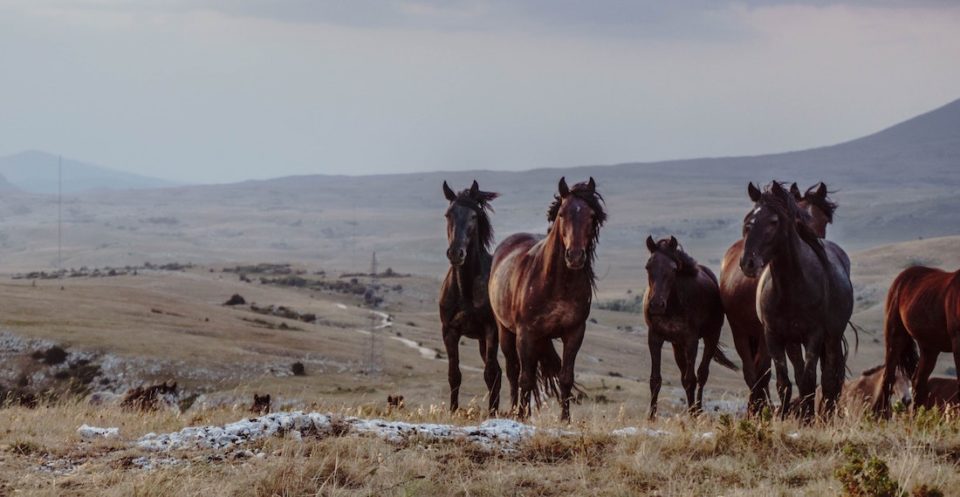I live in a rural county heavily dependent on ranching and agriculture, and though I often hear people talk about threats from large predators like bears or lions, I never hear complaints about wild horses living on our public lands.
Instead, I hear that these animals are living symbols of the American West. From Portland urbanites to Idaho ranchers, and also from the many Indigenous peoples whose forebears called the horse their brother, no one can imagine this region without herds of mustangs and burros running free.
From the federal government it’s a different story. Hewing to a strong pro-livestock bias, the Bureau of Land Management has for decades spun a false narrative about an “overpopulation” of equines that, the agency claims, are in danger of starving and destroying their habitat. The agency would have us dismiss what photographers, tourists and advocates document every day: thriving, robust families of horses living peacefully on vast stretches of federal lands.
The reality is that wild horse populations are negligible compared to the vast numbers of cattle and sheep, to which the BLM allocates up to 80% of forage on designated wild horse Herd Management Areas. The agency complains that 80,000 wild equines is too many, yet omits mention of the 1.5 million cattle and sheep it allows to graze on public lands at the taxpayer-subsidized rate of just $1.35 per animal unit month.
Two prominent, mainstream environmental organizations — Public Employees for Environmental Responsibility and Western Watersheds Project — exposed the BLM’s own grazing data that reveals commercial livestock, not wild horses, responsible for overgrazing. These organizations were joined by the Sierra Club last November in calling on the BLM to stop scapegoating wild equids for rangeland damage that is attributable to vast herds of beef cattle and flocks of sheep.
Then there’s the tired debate about whether wild equines are native to the West. The ancestors of today’s wild herds evolved on the North American landscape over millions of years, paleontologists say. It is true that wild horses were wiped out from their home turf at the end of the last Ice Age — likely by human hunters — but some Indigenous tribes insist the horse never completely died out.
Whether they are a native species that never left this region or are native species reintroduced to their birthplace, wild equines evolved on this landscape. Because cows evolved in the cooler temperate pastures and forests of Europe, they struggle to survive in our harsh, arid ecosystems, while wild horses and burros prosper.
Driving around the West you’ll pass thousands of skinny cows while families of vigorous, healthy horses thrive on public rangelands. And while cattle congregate and trample sensitive riparian areas, wild horses will travel up to 20 miles a day in search for forage. With their simple digestive systems, they help spread native grasses far and wide.
Burros even serve as ecosystem engineers, digging wells in parched desert areas that provide a water source for other wild species. Horses and burros are prey animals that also serve as a food source for native carnivores, which, if spared from extermination to benefit livestock, help regulate wild horse populations.
The horse co-evolved in North America with the lion, the wolf and the grizzly. It’s instructive that while nobody laments the loss of a wild foal to a lion or a wolf, federal officials react fast when a steer or a sheep gets picked off by one of them.
The federal government has a built-in bias against wild horses no matter the critical ecological role they play in promoting rangeland health. The BLM’s wild horse program is largely staffed by self-styled cowboys with a “round ‘em up” mentality for the equines and a “graze-at-your-will” attitude toward livestock.
Where necessary, wild equines can be managed humanely on the landscape with proven fertility control or an emergency gather. But these are the exceptional circumstances.
It’s time to reject the BLM’s false narrative that wild horses harm public lands and embrace an approach that truly protects them. Wild horses and burros belong right where they are.
Scott Beckstead is a contributor to Writers on the Range, writersontherange.org, an independent nonprofit dedicated to spurring lively conversation about the West. The writer lives in Oregon where he teaches classes in animal law and wildlife law. He also serves as director of campaigns for Animal Wellness Action and the Center for a Humane Economy. Photo: Vladimir Vujeva


1 comment
At the beginning, I was still puzzled. Since I read your article, I have been very impressed. It has provided a lot of innovative ideas for my thesis related to gate.io. Thank u. But I still have some doubts, can you help me? Thanks.